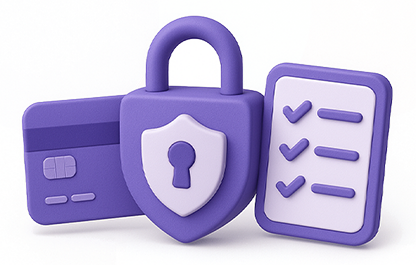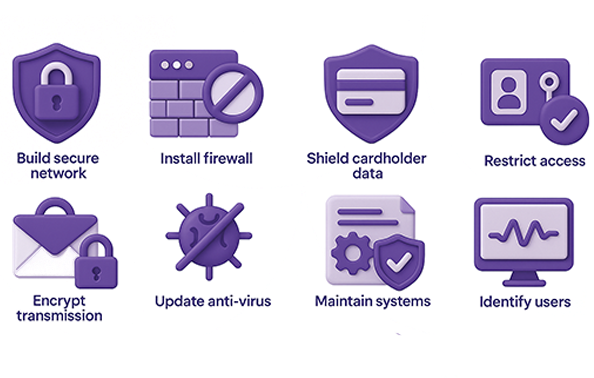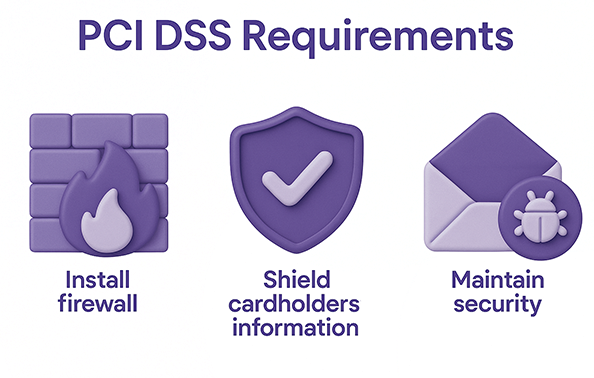- What Is PCI DSS Compliance?
- How Does PCI DSS Make Business Transactions Secure?
- The 12 Core Requirements of PCI DSS
- Know Your PCI DSS Compliance Level?
- Why PCI DSS Compliance Matters for Businesses?
- What Are Significant Steps to Achieve PCI DSS Compliance?
- Common Challenges and How to Overcome PCI DSS Compliance
- The Role of Payment Platforms in Facilitating Compliance
- FAQs
- Conclusion

Comprehensive Guide - What Is PCI DSS Compliance & How Does It Make Business Transactions Secure?
- Kamaljeet Singh
- May 27, 2025
- 10 Mins read
- Payment Gateway
Imagine processing hundreds of customer payments daily, only to discover a data breach compromising sensitive card information.
According to the PCI Security Standards Council. The data types compromised in breaches are 22% card track data, 18% card-not-present (e-commerce), and 16% financial/user credentials.
The increasing cyber threat attacks have made it crucial for merchants and service providers to seek a PCI DSS compliance gateway to strengthen their security, build customer trust, and protect against data breaches and financial penalties.
PCI DSS is a globally accepted security standard that ensures businesses handle sensitive cardholder data securely. It is a framework for businesses to implement strong security measures, avoid data breaches, fraud, and build customer trust.
The payment security standards are mandatory for all organizations that store, process, or transmit cardholder data.
In this comprehensive guide, we will discuss PCI DSS compliance and how it secures customer transactions.
Table of Contents
Let’s get the ball rolling.
What Is PCI DSS Compliance?
The full form of PCI DSS compliance is “Payment Card Industry Data Security Standard”. It is a set of security standards designed to protect cardholder data, sensitive authentication data by ensuring that all businesses processing, storing, or transmitting credit card information maintain a secure environment.
The major card brands, including Visa, Mastercard, Discover, JCB, and American Express, enforce payment security standards.
How Does PCI DSS Make Business Transactions Secure?
Payment Card Industry Data Security Standards work in 5 easy ways. It ensures that business users make transactions securely. This step-by-step process will clear your doubts about integrating a PCI compliance payment gateway for your business’s digital payments.
Step: 1. Secure Network and System Protection
It is for high-value transactions starting from ₹2 lakh. It provides instant settlement for high purchases or sometimes critical business payments.
-
Firewall and secure network configuration: PCI DSS mandates the use of firewall and secure network configuration that ensures restriction to unauthorized access to your business users’ data.
-
Malware Protection: Make sure your company implements and regularly updates anti-virus software and other malware prevention measures to shield systems and networks.
-
Secure system and application: PCI DSS requires organizations to develop and maintain secure systems and applications to eliminate vulnerabilities and avoid data breaches.
Step: 2. Protects Cardholder Data
-
Encryption: Payment Card Industry Council mandates the encryption of cardholder data during transmission and storage to avoid unauthorized access and breaches.
-
Access to Data: Businesses need to restrict cardholder data based on a need to know principle. However, Wonderpay provides a virtual account number to your business. This will assist you eliminate the risk of accessing your customers’ sensitive data.
-
Secure Storage: PCI DSS requires businesses to store cardholder data securely, using encryption or other data protection methods, and prevent unauthorized access to modifications.
Step: 3. Data Transmission Security
- Secure Data Transmission: Payment Card Industry requires companies to encrypt cardholder data at the time of transmission across open, public networks to prevent interception as well as ensure data integrity.
Step: 4. Regular Testing and Monitoring
- Regular security testing: PCI DSS requires businesses to regularly test security systems and processes; it includes vulnerability scans and penetration testing to identify and address potential weaknesses.
Ongoing monitoring: Organizations are told to continuously monitor access to network resources and their users’ card data to detect and respond to security threats promptly.
Step: 5. Information Security Policy
- Maintain an information security policy: Businesses must have an information security policy outlining security practices as well as procedures for managing cardholders’ information.

The 12 Core Requirements of PCI DSS
The 12 core requirements of PCI DSS are like goals that you have to consider. In order to secure cardholder data.
| Why implement PCI DSS? | PCI DSS Requirements |
|---|---|
| The goal is to build and maintain a secure network and systems. | 1. Install and regularly maintain a firewall configuration to protect cardholder data 2. Avoid using vendor-supplied defaults, whether for system passwords or other security parameters. |
| Shield cardholders’ information. | 3. Shield the stored data of the cardholder. 4. Businesses need to encrypt the transmission of cardholder data across the open public network. |
| Maintain a vulnerability management program. | 5. Use and regularly update anti-virus software or programs. 6. Develop and maintain secure systems and applications. |
| Implement strong access control measures. | 7. Access to cardholder data should be restricted to individuals who require it for business purposes. 8. Ensure all access to system components is identified and authenticated. |
| Monitor and test networks regularly. | 9. Limit physical access to cardholder data to authorized personnel only. 10. Implement a tracking and monitoring mechanism for all access to network resources and cardholder data. |
| Maintain an information security policy. | 11. Conduct regular testing of security systems and processes to ensure effectiveness. 12. Establish and maintain an information security policy that applies to all personnel. |
Know Your PCI DSS Compliance Level?
A merchant’s PCI DSS compliance is determined by the number of card transactions processed annually. Below is the detailed discussion for a better understanding to know your Payment Industry Data Security Standard level.
Level: 1
Merchants processing over 6 million card transactions annually come under Level 1.
Level: 2
If you make annual card transactions between 1 to 6 million, you are classified as level 2.
Level: 3
20,000 and 1 million card transactions annually are classified as level 3.
Level: 4
Merchants processing 20,000 card transactions annually are identified as level 4 within PCI DSS compliance.
Why PCI DSS Compliance Matters for Businesses?
PCI DSS compliance is vital for all businesses that maintain and store cardholder data to minimize financial and reputational risks. This section will discuss all the PCI compliance benefits of implementing the Payment Card Industry Data Security Standard.
Data Breach Prevention :
Aims to avoid data breaches by setting security requirements for organizations that handle cardholder data. These requirements cover areas like network security, system and application development, data protection, access control, and security testing.|
Customer Trust:
PCI DSS compliance significantly impacts customer trust by ensuring their payment card data is handled securely. Companies that demonstrate compliance build a trusted relationship with their customers to make payments using their cards, eliminating concerns about data breaches and fraud. The best part of this compliance is to gain customer loyalty and repeat business.
Avoid Penalties:
Why should your business face liabilities and spoil its brand reputation? Your organization can avoid being liable in the future by:
- Prioritizing strong security measures.
- Firewalls.
- Strong password policies.
- Data encryption.
- Regular security assessments.
- You can also train your employees on security best practices.
- Make sure the third-party vendors comply with PCI DSS.
Competitive Advantage:
If you want to stand out in a competitive market. PCI DSS compliance practices will be a competitive advantage for businesses like yours. This will make you stand out of the box by fostering customer trust, mitigating risks, and enhancing cooperative efficiency.
Additionally, PCI DSS helps build strong client relationships, reduce the risk of costly breaches, and even attract new business opportunities.
What Are Significant Steps to Achieve PCI DSS Compliance?
Businesses can achieve compliance by implementing the 12 core PCI DSS requirements, assessing the business’s scope of compliance, implementing necessary security controls, and regularly testing and monitoring the systems and processes.
Assessment:
- Identify cardholder data: You can identify cardholder data and make it easy for you to take inventory of IT assets and business processes for payment card processing.
- Inventory IT Assets: Create an inventory of all IT systems, like applications, and business processes that handle payment card information.
- Vulnerability Analysis: Analyze the identified IT assets, including business processes, for potential vulnerabilities that could expose cardholder data.
- PCI Readiness Assessment: You should conduct a PCI readiness assessment, as it will help you understand the current risks in the environment and how closely the organization aligns with PCI DSS requirements.
Remediation:
- Vulnerability Readiness: Fix vulnerabilities and eliminate storage of cardholder data unless necessary.
- Get Rid of Unnecessary Data Storage: You can delete the cardholder data storage unless it is important.
- Implement Secure Business Processes: It is better to follow secure business processes to reduce the risk of data breaches in the future.
Reporting:
- Self-Assessment Questionnaire: If you are eligible for PCI DSS certification, you can complete the self-assessment questionnaire (SAQ). In order to document your compliance.
- Report on Compliance: If your organization has a higher volume of transactions or complex environments. Therefore, you may need to engage a Qualified Security Assessor (QSA) for a Report on Compliance (ROC).
Continuous Monitoring:
Regularly test security systems and processes, and maintain an information security policy.

Common Challenges and How to Overcome PCI DSS Compliance
You may implement the PCI DSS compliance, which will benefit your business in various ways to build trust, make good relations with your business’s targeted customers, have loyal customers, and more. But what about the challenges to deploy PCI DSS compliance?
Do not worry! This section will discuss the challenges you may experience and how to overcome them.
-
- Resource Constraints: Many businesses lack dedicated IT teams responsible for managing security operations and mitigating potential liabilities.
- Solution: You can consider outsourcing to qualified security assessors (QSAs) or using managed security services.
-
- Complexity of Standards: Understanding and implementing all 12 requirements can be daunting, then what should you be doing?
- Solution: You can break down the requirements into manageable steps and prioritize based on risk assessment.
-
- Maintaining Compliance: One thing that you must consider is that compliance is not a one-time event, but it requires ongoing effort.
- Solution: If you want to overcome or maintain compliance, you can implement continuous monitoring tools and regular staff training.
The Role of Payment Platforms in Facilitating Compliance
Wonderpay facilitates compliance to ensure secure transactions, prevent fraud, and adhere to regulations like PCI DSS. We practice it with features such as encryption, fraud detection, and secure data handling, all by managing the risk associated with online transactions.
-
Integrated Solutions: Wonderpay’s integrated solution streamlines compliance for businesses by taking responsibility for security-sensitive payment data and adhering to significant regulations, including PCI DSS, GDPR, and PSD2. So, you can get a complete solution by eliminating the need for businesses to handle payment information directly, reducing the risk of data breaches and the burden of compliance requirements.
-
Automation: Our PCI DSS payment gateway helps you automate and manage payment processes, monitor transactions, generate reports, and enforce security protocols. As you start using this platform, it will help you streamline operations, reduce manual efforts, and enhance security by identifying and reducing risks in real time.
-
Support and Resources: You get expert guidance and up-to-date compliance information, particularly regarding payment card industry data security standards like PCI DSS compliance and other regulatory requirements.
- You will get built-in security features.
- Risk mitigation strategies.
- You get resources to help you stay informed and compliant.
FAQs
- What are the 4 levels of PCI compliance?
The PCI DSS council determines a merchant’s PCI level based on its volume of card transactions a merchant processes annually. All four levels dictate the specific requirements and procedures a merchant must follow to maintain PCI DSS compliance.
- What are the 12 requirements of PCI DSS compliance?
The 12 requirements of PCI DSS aim to shield cardholder data. It includes:
1. Install and regularly maintain a firewall configuration to protect corporate data.
2. Avoid using vendor-supplied defaults, whether for system passwords or other security measurements.
3. Protect the cardholder data.
4. Encrypt the transmission of cardholder data across the open public network.
5. Use and regulate an updated antivirus software program.
6. Develop and maintain secure systems and applications.
7. Access to cardholder data should be restricted to individuals who require it for business purposes.
8. Ensure all access to system components is identified and authenticated.
9. Ensure to have limited access to cardholder data to authorized personnel only.
10. Implement a tracking and monitoring mechanism for all access to network resources and cardholder data.
11. Conduct regular testing of security systems and processes to ensure effectiveness.
12. Establish and maintain an information security policy that applies to all personnel.
- What is the PCI DSS compliance program?
PCI DSS is a global security standard for protecting cardholder data during transactions. It contains a set of requirements for organizations to ensure a secure environment. The Payment Card Industry Security Standard Council (PCI SSC) is responsible for managing and developing the standards.
- Who needs PCI compliance?
PCI DSS compliance is required for any organization that stores, processes, or transmits cardholder data. It includes credit and debit card numbers, expiration dates, and security codes. Additionally, this includes merchants, payment processors, acquirers, issuers, and service providers, based on their size, as well transaction volume they handle.
- What does PCI stand for?
PCI stands for Payment Card Industry, with another abbreviation, “DSS”, Data Security Standards. If we see the complete information. It will be “Payment Card Industry Data Security Standard” with a payment gateway solution.
Conclusion
By now, you understand how critical PCI DSS compliance is to your business. Whether you are a business owner or a key stakeholder, maintaining secure transactions is essential for earning customer trust and building long-term loyalty.
Introduce secure card payments to your customers, prevent fraud, and protect your business from data breaches that could damage your brand’s reputation.
Wonderpay is your one-stop solution. Our PCI DSS-compliant payment gateway supports pay-ins, pay-outs, instant settlements, free UPI collections, and more—all designed to keep your transactions safe and seamless.
Get in touch with our team today to safeguard your business and ensure uninterrupted operations with a payment gateway you can trust.